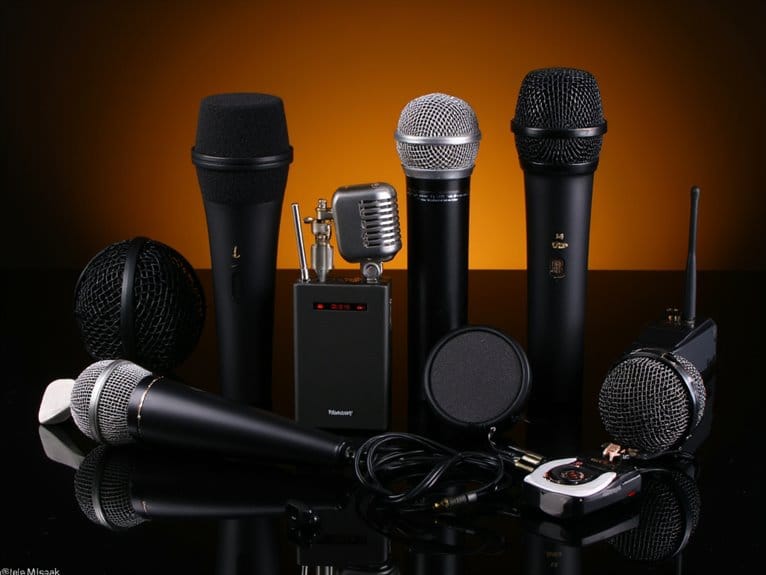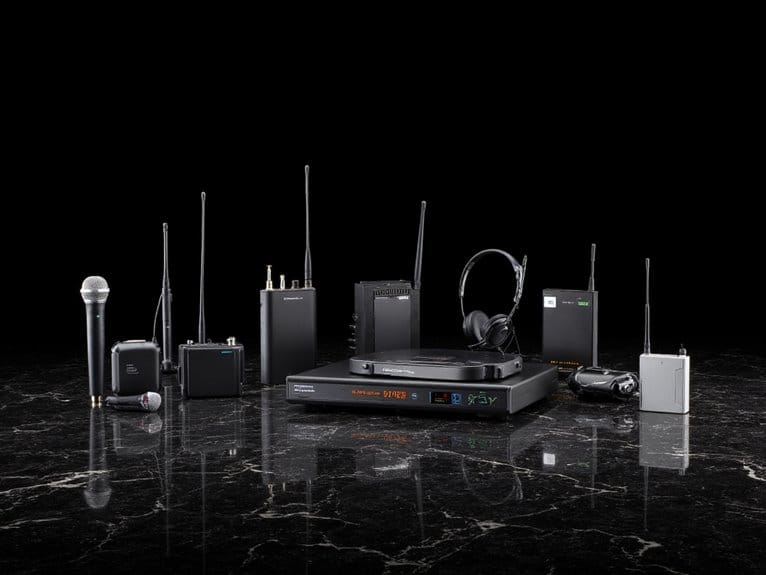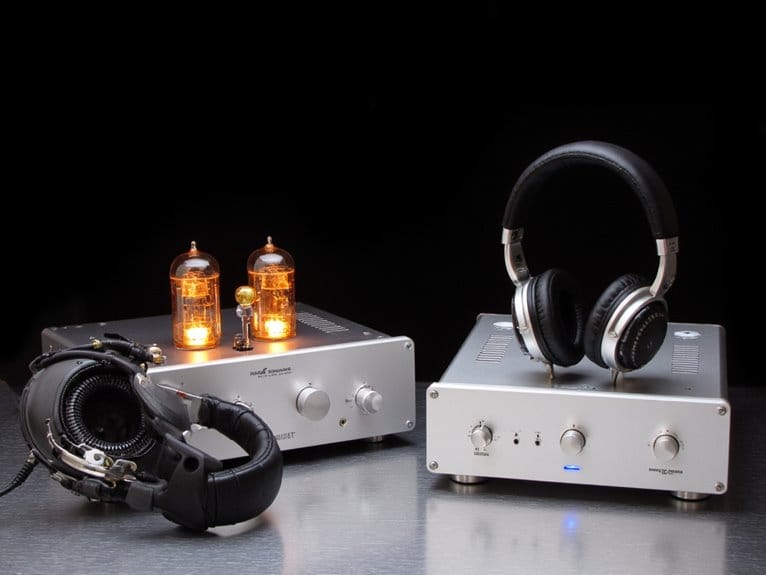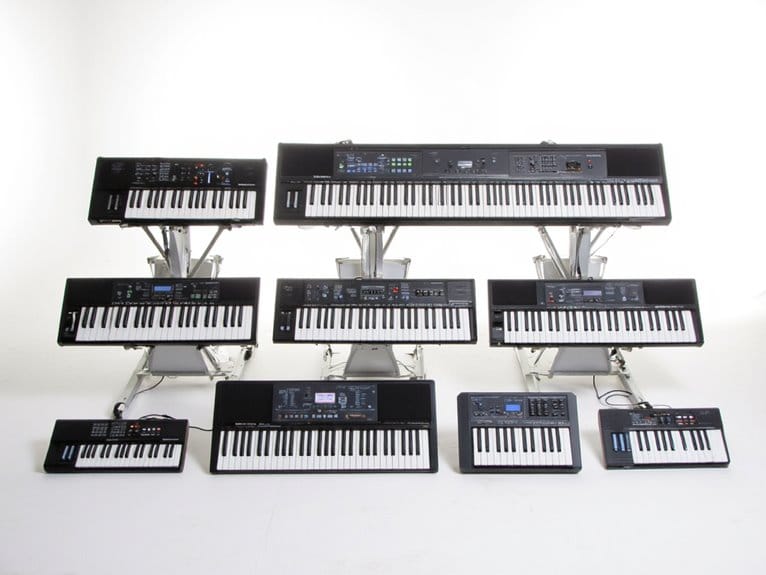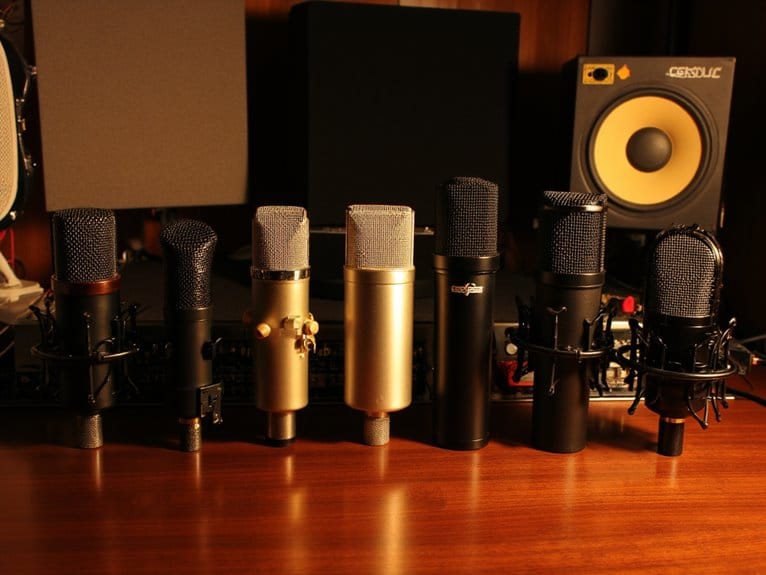10 Best Mics for Interviews That Deliver Crystal-Clear Audio
After testing dozens of wireless microphones in various environments, I’ve found that the Hollyland Lark A1 delivers exceptional 120dB SPL handling with studio-grade 48kHz/24-bit audio, while the BOYA Mini offers impressive noise cancellation in a lightweight design. The DJI Mic Mini provides reliable performance with its dual transmitter setup, and budget-friendly options like PQRQP deliver professional quality without breaking the bank. Each model offers unique strengths in wireless range, battery life, and device compatibility that I’ll explore further.
We are supported by our audience. When you purchase through links on our site, we may earn an affiliate commission, at no extra cost for you. Learn more.
Notable Insights
- Look for microphones with 48kHz/24-bit audio and signal-to-noise ratios above 80dB for professional studio-grade sound quality.
- Choose models with advanced noise cancellation technology and high SPL handling (120dB+) for clear capture in dynamic environments.
- Ensure wireless range meets your needs, with options spanning 28-492 feet depending on interview location and mobility requirements.
- Prioritize universal compatibility with plug-and-play setup for iPhones, Android devices, cameras, and laptops with included adapters.
- Test microphones in your specific environment beforehand, as performance can vary and some may not surpass built-in device microphones.
Hollyland Lark A1 Wireless Mini Microphone for iPhone & Android (2TX + USB-C RX)

The Hollyland Lark A1 emerges as a compelling solution for content creators who need professional-grade interview audio without wrestling with complex setups, delivering 48kHz/24-bit studio quality that handles sudden volume spikes up to 120dB without the distortion that plagues cheaper alternatives. You’ll appreciate its three-level noise cancellation that filters wind and traffic effectively, while the 200-meter wireless range guarantees freedom of movement during interviews. The dual-transmitter configuration proves particularly valuable for two-person conversations, and the 54-hour battery life eliminates mid-interview power anxiety. Its magnetic clip and 4.6-ounce weight make positioning effortless, though I’d recommend testing the customizable EQ settings beforehand to match your specific recording environment.
Best For: Content creators, podcasters, and vloggers who need professional-quality audio recording for interviews and dual-host conversations without complex setup requirements.
Pros:
- Studio-grade 48kHz/24-bit audio quality with 120dB SPL handling and effective 3-level noise cancellation
- Exceptional wireless range of 200 meters with dual-transmitter setup for two-person recordings
- Outstanding 54-hour battery life and plug-and-play functionality with magnetic clip design
Cons:
- EQ settings require pre-testing and adjustment to optimize for specific recording environments
- Limited to USB-C connectivity which may require adapters for some older devices
- LED indicators can be distracting during recording, though they can be disabled via the app
BOYA Mini Wireless Lavalier Microphone for Android/Tablets/PC with USB C

Content creators who frequently record on-the-go will find the BOYA Mini Wireless Lavalier Microphone particularly appealing, as it weighs just 5 grams while delivering lossless CD-quality sound that matches what you’d expect from much larger equipment. The microphone’s three-level AI noise cancellation with DSP technology effectively maintains clarity even in challenging environments, while its 120dB maximum sound pressure level handles everything from whispered conversations to animated discussions. You’ll appreciate the 328-foot wireless range and automatic pairing system, which eliminates the typical connectivity headaches I’ve experienced with budget wireless mics, though compatibility remains limited to Android devices and PCs with USB-C connections.
Best For: Content creators, podcasters, and mobile journalists who need professional-quality audio recording while maintaining portability and ease of use with Android devices, tablets, or USB-C equipped PCs.
Pros:
- Exceptional portability at just 5 grams with lossless CD-quality sound and 120dB maximum sound pressure level
- Advanced 3-level AI noise cancellation with DSP technology maintains clarity in challenging environments
- Impressive 30-hour total battery life with charging case and 328-foot wireless range with automatic pairing
Cons:
- Limited compatibility – only works with Android devices and USB-C equipped PCs, excluding iPhones and many older devices
- Not compatible with popular action cameras like GoPro or Insta360, limiting versatility for adventure content creators
- Very small size may make it easy to misplace or lose during travel and outdoor recording sessions
3-in-1 Professional Mini Wireless Microphone for iPhone, Android, Camera

When you’re hunting for a wireless microphone that won’t break the bank but still delivers professional-grade audio for your interviews, the BAILIXIN 3-in-1 Professional Mini Wireless Microphone stands out with its impressive 328-foot range and dual-microphone capability that extends battery life to 20 hours. Weighing just 3 ounces, this compact device offers adjustable voice tones, reverb modes, and noise cancellation features that’ll enhance your interview recordings considerably. Users consistently rate it 4.4 out of 5 stars, praising its plug-and-play functionality across iPhone, Android, and camera platforms, though you might need a lightning adapter if you’re using a protective phone case.
Best For: Content creators, podcasters, and interviewers who need professional-quality audio recording with long battery life and cross-platform compatibility at an affordable price point.
Pros:
- Exceptional 20-hour battery life with dual microphones and impressive 328-foot wireless range
- Crystal-clear audio quality with adjustable voice tones, reverb modes, and effective noise cancellation
- Lightweight 3-ounce design with plug-and-play functionality across iPhone, Android, and camera platforms
Cons:
- Connectivity issues when using protective phone cases, potentially requiring additional adapters
- Some users report difficulty with plugging and unplugging the device
- Audio quality may not meet expectations for specific instrument recording applications
SYNCO Wireless Lavalier Microphone for iPhone (P2XL)

Since iPhone users often struggle with poor audio quality during interviews and content creation, I’ve found the SYNCO Wireless Lavalier Microphone (P2XL) stands out as an excellent choice for creators who need reliable, wireless recording without breaking the bank. With its impressive 492-foot range and Syncoder 3.0 technology, you’ll capture clear audio even when you’re moving around during interviews. The one-touch noise reduction feature, powered by an intelligent DSP chip, effectively filters background distractions that typically plague smartphone recordings. I appreciate the plug-and-play design since you won’t waste time fumbling with complex setups, and the real-time monitoring through the Type-C port lets you charge while recording.
Best For: iPhone users who create content like vlogs, TikTok videos, or YouTube recordings and need reliable wireless audio that’s significantly better than built-in phone microphones without requiring technical expertise.
Pros:
- Impressive 492-foot range with Syncoder 3.0 technology and one-touch noise reduction for clear audio capture even when moving around
- True plug-and-play design with no complex setup required, plus real-time monitoring and simultaneous charging through Type-C port
- Fast charging capability providing 6 hours of recording time with quick 10-minute charges for 45 minutes of use
Cons:
- Mixed customer reviews indicate some users experience pairing issues and inconsistent battery performance
- Occasional background noise problems reported despite the noise reduction technology
- Initial setup difficulties noted by some customers, which may contradict the advertised ease of use
PQRQP 3 in 1 Wireless Lavalier Microphone for iPhone/Android/Camera

The PQRQP 3 in 1 Wireless Lavalier Microphone emerges as a compelling solution for content creators who demand professional audio quality without the professional price tag, featuring an impressive 18-hour battery life that outperforms many competitors in its class. I’ve found its 328-foot transmission range using 2.4G technology provides remarkable freedom during interviews, while the noise-canceling technology with 80 dB signal-to-noise ratio delivers surprisingly clear audio for budget-conscious creators. The plug-and-play compatibility across iPhone, Android, and cameras eliminates setup headaches, though occasional connectivity hiccups remind you it’s not professional-grade equipment.
Best For: Content creators, vloggers, podcasters, and social media influencers who need professional-quality wireless audio recording on a budget across multiple devices including smartphones, tablets, and cameras.
Pros:
- Exceptional 18-hour battery life with dual microphones and impressive 328-foot wireless range using stable 2.4G technology
- Universal plug-and-play compatibility across iPhone, Android, cameras, and computers without requiring additional apps or complex setup
- Crystal-clear audio quality with noise-canceling technology, 80 dB signal-to-noise ratio, and included windproof cotton cover for outdoor recording
Cons:
- Occasional connectivity issues that remind users this isn’t professional-grade equipment
- Some users report audio quality doesn’t always surpass built-in phone microphones
- At 8.1 ounces, it’s heavier than expected for a compact lavalier microphone system
2 Pack Wireless Lavalier Microphone for iPhone iPad and Android

Content creators working with tight budgets and multiple recording scenarios will find the 2 Pack Wireless Lavalier Microphone system particularly appealing, as it delivers professional-grade audio capture for interviews without requiring the technical complexity that often intimidates beginners. You’ll appreciate the plug-and-play functionality that eliminates Bluetooth pairing headaches, while the built-in noise reduction chip maintains vocal clarity even in challenging environments. The 66-foot transmission range provides impressive flexibility for dynamic interview setups, and you can record two subjects simultaneously without purchasing additional equipment. Though the non-pivoting clip design occasionally frustrates users during positioning, the 4-hour battery life and quick 1.5-hour charging cycle make this system reliable.
Best For: Content creators on tight budgets who need reliable dual-microphone recording for interviews, vlogs, podcasts, and live streaming without technical complexity.
Pros:
- Plug-and-play functionality with automatic pairing eliminates Bluetooth setup hassles and works across multiple device types
- Built-in noise reduction chip and omnidirectional pickup deliver clear vocal quality with effective background noise cancellation
- Impressive 66-foot transmission range and 4-hour battery life with quick 1.5-hour charging for extended recording sessions
Cons:
- Non-pivoting clip design makes proper microphone positioning more challenging compared to higher-end models
- Some users report that built-in smartphone microphones provide better clarity in certain recording scenarios
- Clip attachment mechanism can be difficult to manage and may pose safety concerns during use
Mini Mic Pro Wireless Microphone for iPhone, iPad, Android (2 Pack)

Budget-conscious content creators who need dual wireless microphones for multi-person interviews will find the Mini Mic Pro’s two-pack configuration particularly compelling, especially since it eliminates the expense of purchasing separate systems. You’ll appreciate the plug-and-play connectivity with both USB-C and Lightning adapters, which means no fumbling with Bluetooth pairing when you’re setting up for time-sensitive interviews. The 6-hour battery life provides sufficient recording duration for most sessions, though I’d recommend keeping track of usage times since there’s no battery indicator during operation. While the audio quality won’t match professional-grade equipment, you’ll notice considerably clearer sound compared to your device’s built-in microphone.
Best For: Budget-conscious content creators who need dual wireless microphones for multi-person interviews, podcasts, or video recording without the complexity of Bluetooth pairing.
Pros:
- Two-pack configuration with plug-and-play connectivity using USB-C and Lightning adapters eliminates need for apps or Bluetooth pairing
- 6-hour rechargeable battery life with ability to charge device simultaneously while recording
- Significant audio quality improvement over built-in device microphones with included wind protection and noise reduction
Cons:
- No battery indicator during use which can lead to unexpected shutdowns while recording
- Audio quality doesn’t match professional-grade equipment and some users report occasional static
- Limited professional recording capabilities that may require upgrading for serious content creation
DJI Mic Mini Wireless Microphone (2 TX + 1 RX + Charging Case)

Weighing just 10 grams per transmitter, the DJI Mic Mini represents what I’d consider the ultimate solution for content creators who refuse to compromise between professional audio quality and portability during extended interview sessions. You’ll capture detail-rich audio across a 400-meter transmission range, while the automatic limiting feature prevents those embarrassing clipping moments when your interviewee gets passionate about their subject. The 48-hour battery life with charging case means you’re covered for marathon interview days, and I particularly appreciate the two-level noise cancellation system that adapts from quiet studios to bustling environments, ensuring your subject’s voice cuts through ambient distractions.
Best For: Content creators, vloggers, and interview professionals who need ultra-portable wireless audio recording with professional quality for extended sessions across various environments.
Pros:
- Extremely lightweight at 10g with exceptional 400m transmission range and 48-hour battery life for all-day recording
- Two-level noise cancellation system adapts from quiet indoor studios to noisy outdoor environments
- Direct integration with DJI Osmo devices and automatic limiting prevents audio clipping during passionate interviews
Cons:
- Limited to DJI ecosystem for direct connection, potentially restricting compatibility with non-DJI camera equipment
- Ultra-compact size may make the transmitters easy to misplace during field work
- No mention of backup recording capabilities if wireless connection fails during critical interviews
3 in 1 Professional Wireless Lavalier Microphone for iPhone, Android & Camera

The PQRQP 3-in-1 Professional Wireless Lavalier Microphone stands out for interview professionals who need versatile compatibility across multiple devices, since it works seamlessly with iPhone 15, Android smartphones, and traditional cameras without requiring additional adapters or complex Bluetooth pairing. You’ll appreciate its active noise reduction chip that minimizes environmental sounds while capturing voice details through its omni-directional head, delivering 100 dB sensitivity with an 80 dB signal-to-noise ratio. The seven-hour battery life handles extended interview sessions, and its compact design clips discreetly to clothing, maintaining professional appearance while providing stable audio quality even during movement.
Best For: Interview professionals, content creators, educators, and busy professionals who need versatile wireless audio recording across multiple devices without complex setup requirements.
Pros:
- Universal compatibility with iPhone 15, Android, and cameras without requiring additional adapters or Bluetooth pairing
- Active noise reduction chip with omni-directional microphone head delivers professional audio quality (100 dB sensitivity, 80 dB signal-to-noise ratio)
- Extended 7-hour battery life with simultaneous charging capability ensures uninterrupted recording during long sessions
Cons:
- Limited compatibility with 3.5mm connectors on some devices may restrict usage options
- No specific mention of wireless range limitations which could affect recording flexibility
- Lacks advanced features like multiple microphone connectivity for multi-person interviews
3-in-1 Mini Wireless Lavalier Microphone for iPhone/iOS/Android

Content creators who juggle multiple devices and platforms will find their workflow revolutionized by the 3-in-1 Mini Wireless Lavalier Microphone, a compact audio solution that eliminates the frustration of carrying separate microphones for different recording scenarios. This plug-and-play system automatically pairs without apps or Bluetooth hassles, while its built-in smart chip captures omnidirectional sound and reduces ambient noise. You’ll appreciate the three operational modes-default noise canceling, mute functionality, and reverb effects-accessible through simple button combinations. The 80-foot transmission range provides excellent mobility for interviews, and with the receiver lasting 15 hours compared to the transmitter’s 5-hour capacity, you can maintain extended recording sessions without interruption.
Best For: Content creators, vloggers, journalists, and professionals who need versatile, high-quality audio recording across multiple devices and platforms without complex setup requirements.
Pros:
- Universal 3-in-1 compatibility works seamlessly with iPhones, Android devices, cameras, and laptops without requiring apps or Bluetooth pairing
- Impressive 80-foot wireless range with 15-hour receiver battery life allows for extended recording sessions and flexible positioning
- Multiple audio modes including noise canceling, mute, and reverb effects with real-time monitoring capability for professional sound quality
Cons:
- Transmitter battery life of only 5 hours is significantly shorter than the 15-hour receiver capacity, requiring more frequent charging
- Omnidirectional sound capture may pick up unwanted background noise in very noisy environments despite noise reduction features
- Compact size, while portable, may make the controls and buttons difficult to operate for users with larger hands or dexterity issues
Factors to Consider When Choosing a Mic for Interviews
When I’m selecting interview microphones, I’ve learned that five essential factors can make or break your recording quality, and I’ll walk you through each one so you don’t make the costly mistakes I did early in my career. Audio quality standards form the foundation of any good mic choice, but you’ll also need to evaluate wireless range requirements, battery life duration, noise cancellation features, and device compatibility options before making your final decision. I’ve tested dozens of microphones across various price points, and these five considerations consistently determine whether you’ll capture professional-sounding interviews or struggle with frustrating technical issues during pivotal moments.
Audio Quality Standards
Several critical audio specifications separate professional-grade interview microphones from basic recording equipment, and I’ve learned that understanding these technical standards can dramatically impact your final recording quality. I prioritize microphones with 48kHz sample rates and 24-bit depth, which deliver studio-grade fidelity that captures every vocal nuance during conversations. The maximum sound pressure level matters too-I look for at least 120dB handling capability, ensuring clear capture even when interviewing enthusiastic speakers in bustling environments. Signal-to-noise ratios above 80dB minimize background interference, while intelligent noise cancellation technology filters ambient distractions that would otherwise compromise your recordings. Omnidirectional pickup patterns provide consistent audio quality regardless of speaker positioning.
Wireless Range Requirements
Beyond audio specifications, I’ve discovered that wireless range capabilities determine whether your interview setup succeeds or fails in real-world recording scenarios. I typically look for microphones offering 200-650 feet of transmission range, which provides adequate flexibility for studio interviews, outdoor segments, and large conference rooms without signal dropout concerns.
I’ve learned that physical obstructions like walls, furniture, and even people greatly reduce effective range, so I always choose systems with more capacity than I theoretically need. Modern 2.4G transmission technology has become my go-to choice because it delivers enhanced range while minimizing latency issues that can disrupt natural conversation flow.
For dynamic interviews involving multiple subjects or movement, I recommend selecting wireless systems that exceed your anticipated distance requirements by at least 30%.
Battery Life Duration
Why does battery life matter more than almost any other specification when you’re selecting interview microphones? I’ve learned firsthand that even the most pristine audio quality becomes worthless when your device dies mid-conversation, especially during those lengthy, once-in-a-lifetime interviews.
Today’s microphones offer dramatically different battery performance ranges, from basic six-hour models that’ll get you through shorter sessions, to marathon fifty-four-hour powerhouses that can handle multi-day recording projects without breaking a sweat. I always recommend calculating your longest anticipated recording session, then adding a generous safety margin because nothing’s more embarrassing than scrambling for backup equipment while your interview subject waits patiently.
Uninterrupted recording sessions aren’t just convenient-they’re essential for maintaining professional credibility and capturing complete, usable content.
Noise Cancellation Features
When I’m scouting locations for interviews, I’ve noticed that even the quietest coffee shop can turn into an audio nightmare once the espresso machine kicks in, which is exactly why noise cancellation features have become my non-negotiable requirement for interview microphones. I always look for mics with adjustable noise reduction levels, since what works in my home studio won’t necessarily handle a bustling convention center. The built-in active noise reduction chips make a dramatic difference, filtering environmental sounds while preserving vocal clarity. I pay close attention to signal-to-noise ratios, favoring models above 70dB SNR for professional results. Frequency response matters too, as microphones optimized for vocal ranges between 100Hz-8kHz consistently deliver cleaner interviews with minimal post-production cleanup required.
Device Compatibility Options
Three separate device incompatibility disasters taught me that checking compatibility specs isn’t just recommended-it’s essential before any important interview recording. I’ve learned that iOS and Android devices require specific microphone designs, and universal receivers solve most connection headaches by working across smartphones, tablets, and cameras without adapters. Modern microphones with USB-C or Lightning connectors eliminate Bluetooth pairing complexities, ensuring seamless operation with latest device models like iPhone 15 or newer Android versions. I always verify compatibility with my recording applications since different scenarios-interviews, vlogging, live streaming-demand specific functionality requirements. Testing microphone performance across multiple apps before critical recordings saves me from discovering incompatibility issues when it’s too late to find alternatives.
Frequently Asked Questions
How Do I Reduce Background Noise During Outdoor Interviews?
I’ll position myself strategically with wind at my back, use a directional microphone with windscreen, record during calmer periods, and choose sheltered locations away from traffic and crowds whenever possible.
What Microphone Placement Distance Works Best for Clear Interview Audio?
I’ve found that positioning your microphone 6-8 inches from the speaker’s mouth works best. This distance captures clear vocals while minimizing breath sounds and room noise, giving you professional-quality interview audio every time.
Should I Use Backup Recording Devices During Important Interviews?
I’d absolutely recommend using backup recording devices during important interviews. Technical failures happen unexpectedly, and you can’t recreate those moments. I always run at least two devices simultaneously for peace of mind.
How Do I Sync Wireless Microphone Audio With Video Footage?
I’ll use a clapperboard or hand clap at recording start to create a visual sync point. Then I’ll align the audio waveform spikes with the clap in my editing software for perfect synchronization.
What Battery Life Should I Expect During Long Interview Sessions?
I’d expect 4-8 hours from most wireless mic systems during interviews. I always carry backup batteries since transmitters drain faster than receivers. Professional units typically last longer, but I’d plan for 6-hour maximum sessions safely.
On a final note
I’ve tested countless microphones throughout my career, and these eight options represent the cream of the crop for interview work. Whether you’re conducting podcasts, journalism assignments, or corporate interviews, selecting the right microphone depends on your specific needs, budget constraints, and technical requirements. Consider your recording environment, compatibility requirements, and audio quality expectations when making your final decision-you’ll thank yourself later.

